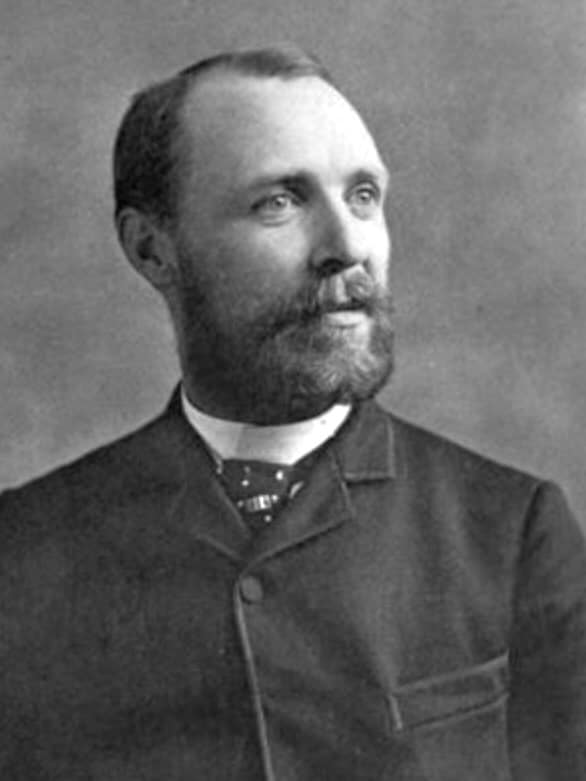William Dabney

William Cecil Dabney (1849-1894) was an American physician and obstetrician
Dabneywas a respected 19th-century American physician, medical educator, and public health advocate who played a pivotal role in shaping clinical medicine and medical licensure in postbellum Virginia. A graduate of the University of Virginia, Dabney served as professor of medicine, obstetrics, and medical jurisprudence at his alma mater, where he influenced a generation of Southern physicians through his lectures and writings. His 1891 publication An Abstract of a Course of Lectures on the Practice of Medicine became a valued educational resource.
Dabney is best remembered for his 1888 description of a “peculiar epidemic” in Charlottesville, later known as epidemic pleurodynia or Bornholm disease. His account of acute pleuritic chest pain during this outbreak provided an early clinical characterisation of a syndrome later confirmed to be of viral aetiology. Known locally as “Devil’s Grip,” this condition contributed to the evolving understanding of atypical chest pain syndromes in both infectious and non-infectious settings.
A committed advocate for sanitation and disease prevention, Dabney championed clean water and urban drainage systems decades before germ theory became dominant. He served as the first president of the Virginia State Board of Medical Examiners and fought to raise professional standards in American medicine. His early death from typhoid fever at age 45 underscored the very public health vulnerabilities he had spent his career working to address.
Biographical Timeline
- Born on July 4, 1849 at “Dunlora,” Albemarle County, Virginia, to William S. Dabney and Susan Fitzhugh Gordon.
- 1868 – Graduated MD from the University of Virginia.
- 1869 – Completed residency in Baltimore
- 1870 – Commenced general practice in Roanoke, Virginia
- 1872–1874 – Temporarily left medicine due to ill health; turned to farming in Albemarle County.
- 1873 – Dissertation on “The value of chemistry to the medical practitioner” awarded the Boylston Prize
- 1874 – Returned to medical practice in Charlottesville; published on connective tissue and gave the Annual Address at the Medical Society of Virginia on “Preventable Causes of Disease.”
- 1875 – Advocated for public health reforms including clean water and drainage systems.
- 1878–1881 – Traveled to Japan and later California due to recurring health issues; returned permanently to Virginia in 1882.
- 1883 – Campaigned for standardized medical licensure in Virginia.
- 1884 – Elected first president of the newly formed Virginia State Board of Medical Examiners.
- 1886 – Appointed Professor of Practice of Medicine, Obstetrics, and Medical Jurisprudence at the University of Virginia.
- 1888 – Published seminal paper on an epidemic of pleurodynia, the “Devil’s Grip” in Charlottesville
- 1891 – Published An abstract of a course of lectures on the practice of medicine
- Died on August 20, 1894 of typhoid fever, aged 45, and buried at the University Cemetery in Charlottesville.
Medical Eponyms
Bornholm disease (‘Devil’s grip’ in 1888)
Pleurodynia is an acute, self-limited viral illness characterised by sudden-onset, stabbing chest or upper abdominal pain, often accompanied by fever and malaise. The pain is typically pleuritic and intermittent, localised to the chest wall or epigastrium, and worsened by movement or respiration. The condition is caused primarily by coxsackievirus B, and less frequently echoviruses.
1888 – Dabney reported an outbreak of a “peculiar epidemic” in Charlottesville, Virginia, marked by intense chest pain with pleuritic features, and systemic symptoms, which he termed “epidemic pleurodynia”. Local patients referred to the illness colloquially as “Devil’s Grip” or a type of grippe (flu-like illness).
[The child] had been taken suddenly a few hours before with violent pain in the left side of the chest nearly over the region of the heart. His temperature was 103°F and the skin extremely hot and pungent to the touch…His chief complaint was of the pain in the chest, which was excruciating and aggravated by the slightest movement, or by drawing a long breath. Nothing abnormal could be discovered about the thoracic organs, however, on physical examination.
Dabney 1888
Dabney described 29 cases in all, and “saw at least as many more subsequently, but, being extremely busy with the final examinations of the medical students, did not take notes of them.” The Virginia epidemic was notable for its occurrence in children, including one of Dr. Dabney’s, and its familial distribution.
The pain was by far the most striking feature. In character it was usually sharp and lancinating, and was much more violent when the patient attempted to move or to draw a deep breath. (So agonizing was this pain that it was nicknamed the “devil’s grip” by a sufferer from the disease in Rappahannock County, Virginia, and this name became a common one there afterward, as I was told by Dr. W. F. Cooper.) There was slight tenderness over the seat of pain in every case, but it was not nearly so marked as the pain itself. The seat of the pain was usually in the left side of the chest just below the nipple but in some of the cases there was pain in the opposite side, or in the shoulder of the opposite side; and in a few of the cases, especially in children, there was pain in the abdomen, usually in the epigastric region
Dabney 1888
The same clinical syndrome was recognised in Europe during World War I and formally described in outbreaks from Bornholm Island, Denmark, in the 1930s. The term Bornholm disease was coined by Ejnar Sylvest (1933), and the viral aetiology (coxsackie B viruses) was confirmed in the 1940s.
Modern perspective:
- Cause: Most commonly coxsackievirus B; enteroviral in origin
- Symptoms: Acute onset chest or abdominal pain, fever, myalgia
- Course: Self-limiting over 3–7 days
- Diagnosis: Clinical; may confirm with viral PCR/serology in outbreaks
- Treatment: Supportive care with NSAIDs and rest
Key Medical Contributions
Public Health Advocacy (1870s–1880s)
Dabney emphasised “preventable causes of disease”, arguing for clean water, proper drainage, and sanitation in Virginia towns. His Annual Address to the Medical Society of Virginia positioned him as an early advocate for environmental public health and epidemiological thinking in the South.
Teaching in Obstetrics and Medical Jurisprudence (1886–1894)
As Professor of Practice of Medicine, Obstetrics, and Medical Jurisprudence at the University of Virginia, Dabney was a central educator in foundational clinical disciplines. Though few of his obstetric teachings survive in print, his lecture compendium An Abstract of a Course of Lectures on the Practice of Medicine (1891) was widely used.
Typhoid Fever (1894)
Dabney died of typhoid fever in 1894, a tragic irony given his advocacy for improved sanitation and clean water systems. Although he did not publish a major treatise on typhoid, his death reflects the disease’s prominence in 19th-century public health and the limitations of treatment before antibiotics.
Major Publications
- Dabney WC. The value of chemistry to the medical practitioner: a dissertation to which was awarded the Boylston Prize, June 5th, 1873
- Dabney WC. Account of an Epidemic Resembling Dengue Which Occurred in and Around Charlottesville and the University of Virginia in June, 1888, American Journal of the Medical Sciences. 1888; 96: 488-494
- Dabney WC. The atypical forms of typhoid fever. Medical Society of Virginia. 1888
- Dabney WC. An abstract of a course of lectures on the practice of medicine. 1891
- Dabney WC. The aims and methods of medical education. 1893
- Dabney WC. An outbreak of typhoid fever presenting unusual features. Medical News 1893; 63(23): 630-632
References
Biography
- Obituary: William Cecil Dabney, M. D. Virginia Magazine of History and Biography. 1895; 2(3): 332-333
- Leavell BS. Distinguished Virginia professor: Dr. William Cecil Dabney. Va Med. 1979; 106(11): 799-803
- Bibliography. Dabney, William C. WorldCat Identities
Eponymous terms
- Spencer FJ. The Devil and William Dabney. An Epidemiological Postscript. JAMA. 1966; 195(8): 645-8.
Eponym
the person behind the name
MB BCh BAO, Queen’s Belfast. Recently moved to Australia, interested in Emergency Medicine, Medical Education and Paediatrics. Keen baker & tea drinker!
BA MA (Oxon) MBChB (Edin) FACEM FFSEM. Emergency physician, Sir Charles Gairdner Hospital. Passion for rugby; medical history; medical education; and asynchronous learning #FOAMed evangelist. Co-founder and CTO of Life in the Fast lane | On Call: Principles and Protocol 4e| Eponyms | Books |

